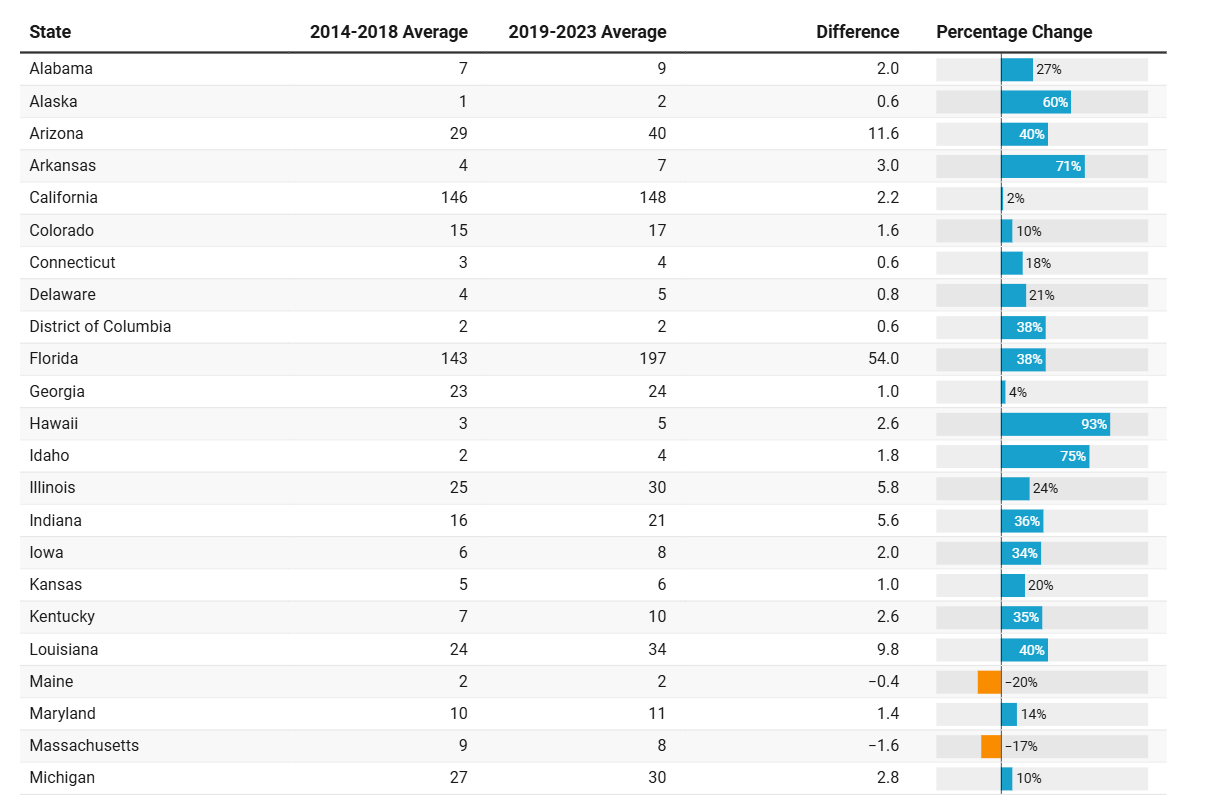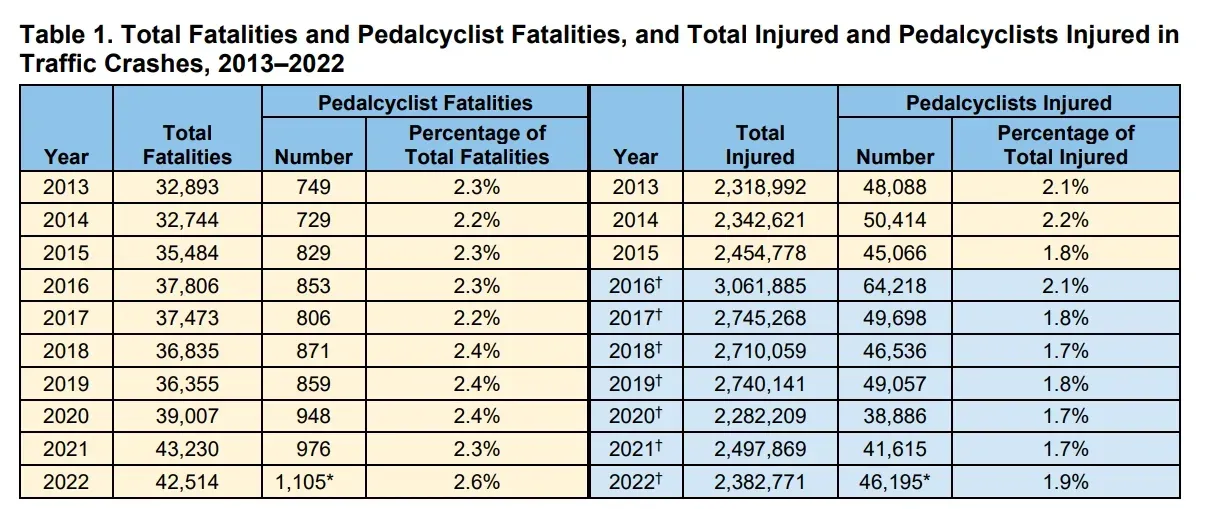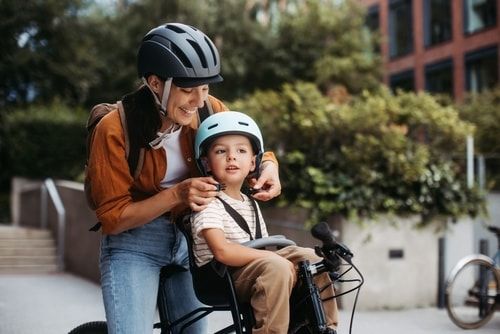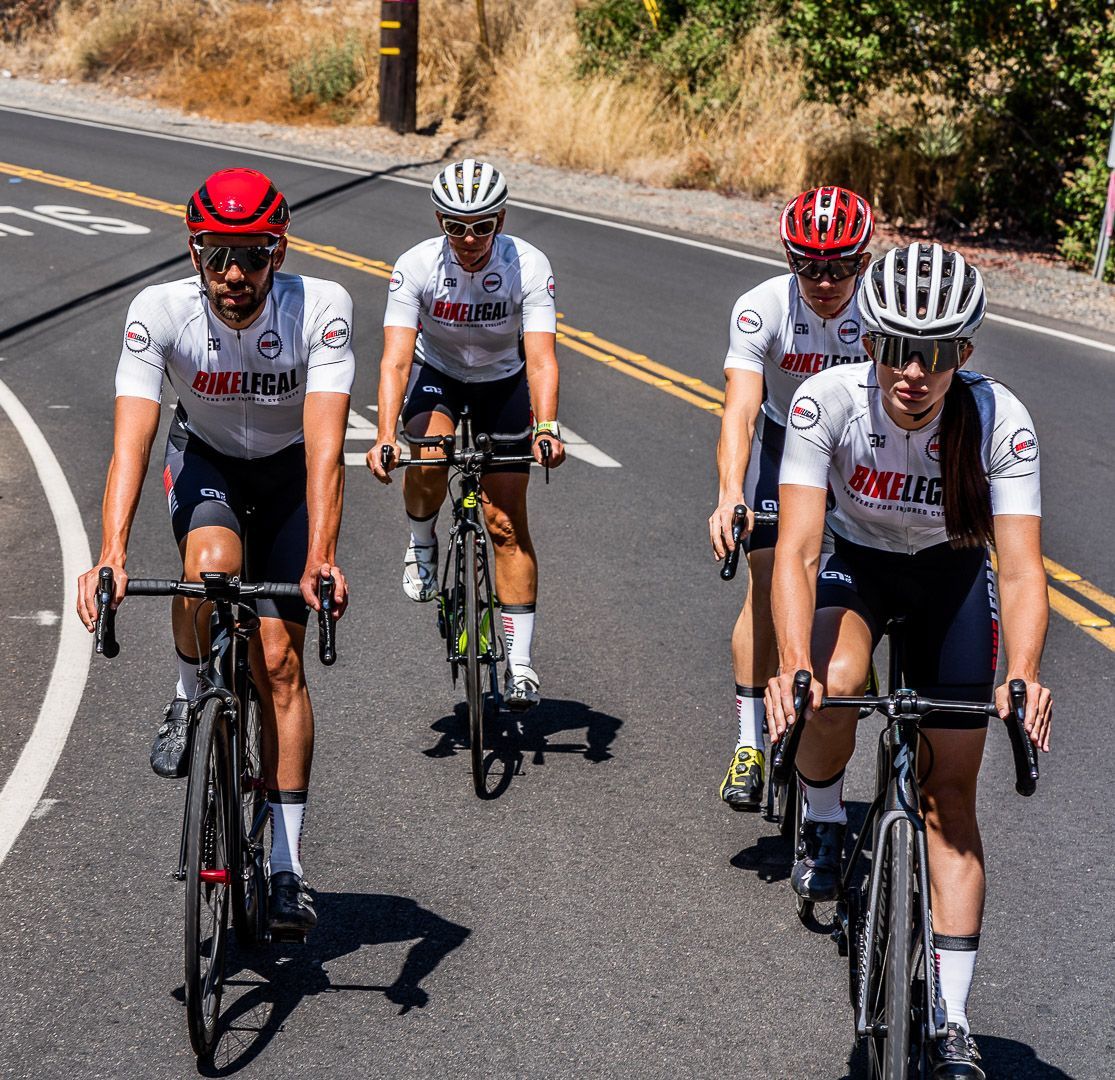Bike to Work & Bike Safety Month: Everything Cyclists Should Know in 2025
Follow us on
social media!
Over the past decade, fatalities involving cyclists have increased by 53%, highlighting a critical need for greater awareness and safer roads. While more Americans are embracing cycling as a mode of transportation, fitness, and recreation, the rise in fatalities shows a disconnect that cannot be ignored.
National Bike Month provides an essential opportunity to shine a light on this issue, advocate for safer streets, and continue promoting cycling as a healthy, eco-friendly choice for everyone.
This guide covers everything you need to know about celebrating Bike Month in 2025, including:
- Key dates, nationwide events, and how to participate
- The many benefits of cycling—from personal health to environmental impact
- Essential safety tips and legal protections every cyclist should understand
What Is National Bike Month and Bike Safety Month?

National Bike Month, established in 1956 by the League of American Bicyclists, is a nationwide celebration held each May to promote cycling as a viable and enjoyable mode of transportation. What began as a simple awareness campaign has evolved into a comprehensive month of activities celebrating the many benefits of biking while advocating for safer streets and better infrastructure.
Bike Month focuses on the joy of cycling and the importance of safety. The goals include:
- Encourage more people to ride a bike instead of driving to work or school
- Educate both cyclists and motorists about sharing the road safely
- Advocate for better cycling infrastructure in communities across America
- Highlight the health, environmental, and economic benefits of cycling
The true impact of Bike Month is felt at the local level. Across cities and small towns alike, bike shops, schools, local businesses, and community organizations host events and activities that reflect the needs and character of their own neighborhoods.
When Is National Bike Month? Key Dates for 2025
Mark your calendars for these important Bike Month dates in 2025:
- National Bike Month: The entire month of May
- National Ride a Bike Day: Sunday, May 4, 2025
- Bike to School Day: Wednesday, May 7, 2025
- Bike to Work Week: May 12–18, 2025
- Bike to Work Day: Friday, May 16, 2025
These dates structure the month-long celebration, with specific days focused on different aspects of cycling.
National Ride a Bike Day kicks off the month, inviting everyone to enjoy a ride and experience the joy of cycling. Following this, Bike to School Day encourages young riders to explore cycling as a fun, active way to get to school. The focus then shifts to commuting during Bike to Work Week and Bike to Work Day, where cycling is highlighted as an effective and sustainable transportation choice.
The History of National Bike Month
The League of American Bicyclists founded National Bike Month in 1956 as part of their mission to create a bicycle-friendly America. Initially, the focus was primarily on promoting cycling as a healthy recreational activity and a viable transportation alternative.
Over the decades, the celebration has evolved significantly:
- 1950s-1960s: Early celebrations centered on recreational riding and safety awareness
- 1970s-1980s: By the early '80s, the event became National Bike Month, emphasizing environmental and transportation goals, highlighting cycling as a cost-effective, eco-friendly alternative during the energy crisis.
- 1990s-2000s: The focus expanded to include promoting cycling as a health activity and greater investment in bike infrastructure like lanes and trails.
Today's Bike Month reflects this evolution, balancing celebration with advocacy, recreation with transportation, and individual benefits with community impacts. Adding specific events like Bike to Work Day (started in 1956) and National Ride a Bike Day (established in 2021) has helped create a more structured approach to the month-long celebration.
Why National Bike Month Matters More Than Ever
In 2025, National Bike Month holds significant value as cycling continues to grow in popularity while facing increasing safety challenges. The month provides an important opportunity to:
Highlight the Benefits of Cycling
Cycling offers tremendous benefits—improved cardiovascular health, reduced emissions, decreased traffic congestion, and stronger local communities. National Bike Month emphasizes these benefits, encouraging more people to make cycling a regular part of their lives.
Address Rising Safety Concerns
With cyclist fatalities increasing 53% over the past decade, safety awareness has never been more urgent. This alarming trend demands coordinated action through education, infrastructure improvements, and policy changes. Bike Month brings these issues to the forefront, helping cyclists and motorists understand their roles in creating safer streets.
Build a Culture of Shared Respect
Perhaps most importantly, Bike Month fosters dialogue between cyclists, motorists, and community planners. By highlighting both the joys of cycling and the challenges cyclists face, the month helps build mutual understanding and respect among all road users. This cultural shift toward seeing cycling as a legitimate transportation mode, not just recreation, is essential for creating truly bike-friendly communities with safer streets for everyone.
The Benefits of Commuting by Bicycle

Cycling to work isn't just about avoiding traffic jams—it's about integrating physical activity into your daily routine, reducing your carbon footprint, and saving significant money on transportation costs.
Health Benefits
Cycling to work delivers impressive physical health improvements. According to the research conducted by the National Institutes of Health (NIH), cycling to work was associated with a 41% lower risk of mortality compared to non-active commuting (car/motor vehicle or public transport).
Regular bike commuters' experience:
- Improved Cardiovascular Health: Regular cycling for just 30 minutes a day can profoundly impact heart health. It strengthens the heart, lowers resting heart rate, and helps reduce blood pressure, making it an excellent form of cardiovascular exercise.
- Weight management: Steady cycling burns approximately 300 calories per hour, equivalent to what you'd burn in a structured gym workout. The best part? Unlike inconsistent exercise routines, cycling to work seamlessly integrates physical activity into your daily routine, making it easier to maintain over the long term.
- Increased lifespan: According to Environmental Health Perspectives, cycling for short trips can increase your estimated life expectancy by 3-14 months.
- Better mental health: Cycling significantly boosts mental wellbeing beyond physical benefits. Bike commuters report lower stress levels, improved sleep patterns, and enhanced overall mood.
- Fewer sick days: Studies show cyclists take 8% to 12% fewer sick days than car commuters, making bike commuting beneficial for personal health and workplace productivity.
Environmental Benefits
Cycling plays a vital role in creating a healthier planet:
- Lesser Carbon emissions: Bicycles generate just 21g of CO₂ per passenger/km compared to 271g for passenger cars—a 92% reduction. Furthermore, e-bikes emit approximately 14.8g CO₂.
- Reduced traffic congestion: Every person who switches from driving to cycling helps reduce traffic congestion. During the 1996 Atlanta Olympics, a 23% reduction in morning traffic resulted in ozone concentrations dropping by 28% and acute asthma care visits decreasing by 41.6%.
- Lower noise pollution: Bicycles are nearly silent compared to cars, making them a powerful tool for reducing urban noise pollution. More people cycling instead of driving creates quieter, more peaceful communities.
Economic Benefits
Riding a bike isn't just good for your health and the planet—it's great for your wallet too:
- Direct cost savings: According to the 2024 AAA Your Driving Costs study, the total cost to own and operate a new vehicle was $12,297 annually. By contrast, bicycle maintenance typically costs $100-300 per year, with initial purchase prices ranging from a few hundred to a few thousand dollars.
- Potential Tax Benefits: Several states are offering e-bike incentives to promote sustainable transportation:
- Colorado: $500 tax credit for electric bike purchases.
- Maine: Expands its electric vehicle rebate program. The state aims to dedicate up to $500,000 to fund the addition of e-bikes.
- Minnesota: Offers $1,500 rebates or 50-75% of the cost of a new e-bike and safety accessories.
- Vermont: Provides up to $5,000 for income-eligible residents to replace aging and high-emitting internal combustion engine vehicles with e-bikes.
- Washington: Offers rebates up to $1,200 for e-bike purchases for low-income individuals.
How to Participate in National Bike Month Events
Getting involved in Bike Month can be rewarding, whether you're a seasoned cyclist or just dusting off an old bike. Here are ways to participate:
Join Local Events
Communities across the country organize events throughout May. Look for:
- Bike-to-Work Breakfasts: Many cities host rest stops and refreshment stations with complimentary breakfast for cyclists.
- Maintenance workshops: Learn basic repair skills at free or low-cost clinics
- Bike rodeos: Fun events teaching children safe riding skills
- Advocacy meetings: Join discussions about improving cycling infrastructure in your community
Check with local cycling organizations, bike shops, libraries, and city recreation departments for nearby events. The League of American Bicyclists also maintains a nationwide events calendar.
Take the National Bike Month Challenge
The National Bike Month Challenge encourages participants to track their rides throughout May, competing with others nationwide for bragging rights. To participate:
- Register on the Love to Ride platform (the official challenge host)
- Log your rides throughout May, either through the app, by syncing with Strava, or by logging directly on the website
- Encourage friends and colleagues to join
- Win prizes and recognition based on miles ridden
The challenge is designed to accommodate all levels, from beginners to experienced cyclists, making it accessible for anyone wanting to participate.
Advocate for Better Infrastructure and Cyclist Safety
Use Bike Month as an opportunity to push for improved cycling conditions in your community:
- Attend city council meetings to speak about cycling issues
- Write to local officials about specific infrastructure needs
- Organize or join a "ride of silence" to honor cyclists injured or killed on public roads
- Document and report dangerous road conditions to local transportation departments
- Join or support local bicycle advocacy organizations working for safer streets
- Support legislation that protects cyclists, such as the Magnus White Cyclist Safety Act
Commute by Bike During Bike Month 2025
The simplest way to participate is to ride your bike for transportation:
- Start small: If you're new to biking, try riding once a week and gradually increase
- Find a mentor: Connect with experienced commuters for route advice and tips
- Share your journey: Post about your bike commuting experiences on social media with #BikeMonth
- Bring others along: Organize a "bike bus" with colleagues or neighbors to ride together
Even replacing one car trip per week with a bike ride can be beneficial for your health, the environment, and your community.
National Bike Month 2025 Events Across the US
Bike Month offers a variety of events across communities nationwide. Here are some highlights from major cities in 2025:
- New York City: The TD Five Boro Bike Tour kicks off Bike Month on the first Sunday in May, closing 40 miles of NYC streets to cars and welcoming 32,000 cyclists. Organized by Bike New York, the event raises funds to provide free bike education, advocacy, and community outreach programming.
- San Francisco: The Bay Area celebrates Bike to Wherever Day on May 15, with energizer stations throughout the region offering refreshments, commemorative bags, etc. The San Francisco Bicycle Coalition organizes numerous events, including group rides, challenges, etc.
- Portland: The city's extensive Bike Month calendar includes community bike rides, the Southwest neighborhood bike fair, bike maintenance workshops, etc. The city is hosting events to encourage safe cycling and enhance local bike culture.
- San Diego: San Diego kicks off Bike Month with various events throughout May, including group rides, bike classes, and community promotions. Highlights include Bike Anywhere Day on May 15, instructor-guided rides, and special business promotions for cyclists.
- Los Angeles: Los Angeles celebrates Bike Month with exciting events throughout May, including free bike share passes and guided community rides. Highlights include the "Bike Night" at Union Station, bike-to-work pit stops, and special promotions such as discounted passes and free 30-minute rides on Bike Anywhere Day, May 15.
- Chicago: Chicago Bike Month, organized by the Active Transportation Alliance, runs throughout May, hosting events like the Bike Commuter Challenge, Ride of Silence on May 21, and National Bike & Roll to School Day on May 7. The month also features community rides, bike repair clinics, and advocacy events to promote biking across the city.
- Houston: The city kicks off Bike Month with the First Sunday Ride on May 4, starting at Trek Bicycle Clear Lake, followed by Bike to Work Day on May 15 at the Terry Hershey Park Gazebo in the Energy Corridor.
For a complete list of Bike Month events happening across the country, visit the League of American Bicyclists' nationwide events calendar.
Why Bicycle Safety Awareness Is Critical
As more people embrace cycling, it’s crucial to understand the risks involved and how to mitigate them. May Bike Month is not just about celebration—it’s also a time for education and advocacy, ensuring cyclists of all ages can ride confidently and safely.
Dangers and Statistics
The numbers tell a sobering story about bicycle safety in the country:
- Rising fatalities: 1,377 fatalities occurred in 2023—a 53% increase since 2014, according to the National Safety Council.
- High-Risk Areas: 85% of fatal cyclist crashes occur in urban areas, with 62% taking place at non-intersection locations where drivers may not anticipate the presence of cyclists.
- Vehicles Involved: Collisions involving light trucks (SUVs, pickups, and vans) account for 46% of cyclist fatalities.
- Demographic Trends: Male cyclists represent 86% of fatalities, with the average age of deceased cyclists being 49, challenging the assumption that bicycle safety is primarily a concern for younger riders.
- Injuries: In addition to fatalities, over 42,000 cyclists are injured in roadway crashes annually, with many minor incidents going unreported.
Here’s the data showing injuries and fatalities across various states, as well as the national trends in fatalities and injuries between 2021 and 2022:


For a detailed analysis of bicycle accident statistics and trends, please refer to our comprehensive article: 2022 Bicycle Injury & Fatality Statistics (2024 Data): Cyclist Deaths On The Rise in the U.S.
Tips for Commuting to Work or School
Commuting by bike requires a practical approach that balances safety, efficiency, and responsibility. Understanding the rules of the road, using the right gear, and choosing safe routes are essential for a successful ride.
Bike Etiquette
Good cycling etiquette isn't just about courtesy—it's about safety for yourself and others:
- Follow traffic flow: Always ride in the same direction as traffic.
- Signal your intentions: Use hand signals to communicate turns. This predictability helps drivers anticipate your movements and reduces crash risk.
- Stay alert: Avoid playing music or using noise-canceling headphones while riding. Being able to hear your surroundings is essential for your safety, allowing you to respond to traffic, pedestrians, and potential hazards.
- Ride predictably: Avoid weaving between cars, making sudden movements, or riding too close to parked vehicles (watch for opening doors!).
Most states ban the use of earphones in both ears while cycling for safety reasons. To learn more about the legality of riding a bike with headphones, check our guide on cycling with earphones.
Safety Gear Checklist

The right gear can significantly reduce your risk of injury:
- Helmet: Always wear a properly fitting helmet. A bicycle helmet reduces the risk of head injuries by up to 85% in crashes. For guidance on selecting the right helmet, check our Ultimate Bicycle Helmet Guide.
- Lights: Use front (white) and rear (red) lights—even in daylight. At night, make sure your lights are visible from at least 500 feet away, as required by most state laws.
- Visibility gear: Wear bright, reflective clothing, especially in low-light conditions.
- Bell or horn: A signaling device helps alert pedestrians and other cyclists of your presence.
- Weather-appropriate gear: Wear a waterproof jacket on rainy days and layer up for colder weather. Keep in mind that you’ll warm up once you start pedaling, so it’s better to dress slightly cooler.
When choosing lights for your bike, it's important to understand how bright your lights should be for different conditions. For detailed guidance, check out our Bicycle Light Lumens Guide: How Bright Should Your Lights Be?
Route Planning for Safety
Choosing the right route can significantly enhance your safety and overall commuting experience.
- Choose bike-friendly routes: Prioritize streets with dedicated bike lanes, cycle tracks, or low traffic volumes. Apps like Google Maps, Strava, and Ride with GPS can help identify bike-friendly routes in your area.
- Avoid high-traffic areas: When possible, select routes that avoid busy intersections, high-speed roads, and known danger spots. A slightly longer route on quieter streets is often safer and more pleasant.
Bike Safety Tips
Beyond gear and route planning, these riding practices will help keep you safe:
- Ride in the direction of traffic: Always ride in the same direction as traffic to ensure better predictability and visibility. Not only is it safer, it's the law!
- Be predictable: Maintain a straight, predictable line and signal your intentions well in advance. Don't weave in an out of traffic.
- Anticipate driver behavior: Always assume that drivers haven't seen you. Look for signs of turning vehicles and avoid riding in their blind spots.
- Use bike lanes when available: Whenever possible, stick to designated bike lanes. If there are no bike lanes, ride as far to the right as possible to avoid impeding traffic.
- Prevent dooring: Keep a safe distance (3-4 feet) from parked cars to avoid being hit by suddenly opened doors. This "door zone" is one of the most common hazard areas for urban cyclists.
- Be aware of pedestrians: Yield to pedestrians at crosswalks and always be cautious when riding through busy areas with foot traffic. This helps prevent cycling accidents with pedestrians.
- Make eye contact: When approaching intersections or potential conflict points, try to make eye contact with drivers to ensure they've seen you.
For a more detailed overview of essential cycling rules, safety tips, and how to share the road with other vehicles, check out our Bicycle Etiquette Guide: Essential Rules and Safety Tips for Cyclists.
Helpful Technology
Modern technology can enhance your commuting safety and enjoyment:
- Cycling apps: Tools like Strava, Ride with GPS, and Komoot offer route planning with cycling-specific features like elevation profiles and surface types.
- Smart helmets: Advanced helmets now come with integrated lights, turn signals, and crash detection systems that can alert emergency contacts if you're involved in an accident.
- Bike cameras (dash-cams for cyclists): Handlebar and seatpost-mounted cameras provide valuable video evidence in case of a crash, or road rage incident. It can help prove fault, document traffic conditions, and protect cyclists legally by capturing exactly what happened on the road.
- Smart bike locks: GPS-enabled locks allow you to track your bike’s location and receive alerts if it is tampered with. This can help prevent theft and give you confidence when locking your bike in public spaces.
- Radar systems: Rear-facing radar systems can alert you to approaching vehicles, helping you monitor traffic without constantly looking back. Some products integrate radar, light, and a camera.
For a detailed exploration of the latest in bicycle safety technology, check out our guide on the 16 Best Bicycle Safety Accessories and Technology.
Key US Bicycle Laws to Obey
Understanding bicycle laws is essential for riding and commuting during Bike Month. While laws vary by state and local jurisdiction, here are the key regulations that apply across most of the United States:
RULES FOR CYCLISTS:
In the U.S., bicycles are legally considered vehicles, which means cyclists must follow the same traffic laws as drivers. This includes obeying traffic signals, riding in the direction of traffic, yielding when required, and signaling turns.
Many states also have specific laws for cyclists, such as safe passing distances, helmet requirements, and rules for riding on sidewalks or in bike lanes. Additionally, local and state laws may include extra requirements or allowances. For example, some states have adopted the “Idaho Stop” law, which allows cyclists to treat stop signs as yield signs and, in some cases, red lights as stop signs—an exception not permitted in most vehicle traffic laws.
Stop Lights, Stop Signs, and Rolling Stop Rules (Idaho Stop) for Cyclists:
- Cyclists must obey all traffic signals, signs, and pavement markings
- In some states, cyclists may treat stop signs as yield signs (the "Idaho Stop")
- As of 2025, the following states have adopted some form of the Idaho Stop law: Arizona, Arkansas, Colorado, Delaware, Idaho, Minnesota, New Mexico, North Dakota, Oklahoma, Oregon, Utah, and Washington
For more detailed information on stop sign laws for cyclists, see our article Do Cyclists Have to Stop at Stop Signs?
Right-of-Way Rules:
- Yield to pedestrians at crosswalks and intersections
- Follow the same right-of-way rules as motor vehicles at intersections
- When changing lanes, yield to vehicles already in the lane you intend to enter
Lane Positioning and Road Sharing:
- Stay to the right side of the road when practical and safe
- "Take the lane" when lanes are too narrow for cars to pass safely (approximately 14 feet)
- Use the rightmost lane available in your direction of travel at multi-lane intersections
Lighting and Reflector Requirements:
- Most states require a white front light visible from at least 500 feet
- Red rear reflector or light visible from varying distances (state-dependent)
- Additional reflectors on pedals or wheels may be required in some jurisdictions
Sidewalk Riding Permissions:
- Some states prohibit sidewalk riding entirely. Others allow it except in business districts
- Many leave the decision to local municipalities
- Age restrictions may apply in certain areas
For more information on sidewalk riding laws, read our article Can You Ride a Bike on the Sidewalk in the U.S.?
RULES FOR DRIVERS:
Below are the key rules that drivers must follow when interacting with cyclists.
Three-Foot Passing Laws:
- Most states have adopted a minimum 3-foot passing distance (3-feet law) for vehicles overtaking cyclists
- Some states like Pennsylvania require even wider buffers (4 feet)
- California's Omni Bike Law requires drivers to change lanes when passing a cyclist if another lane is available.
- Enforcement and penalties vary widely by jurisdiction
Dooring Laws and Liability:
- Many states have specific laws prohibiting opening car doors into traffic
- Liability typically falls on the person opening the door
- Penalties can include fines and, in some cases, criminal charges if the incident results in injury.
For a comprehensive overview of the cycling laws across the United States, check out our guide on Cycling Laws in the United States.
Keep Your Bike Safe During Bike Month
With more people riding during National Bike Month, bike thefts can spike especially near transit stops, schools, and workplaces. Protect your ride by using a high-quality U-lock to secure the frame and rear wheel to a fixed object. Add a second lock for the front wheel and avoid leaving your bike in the same place every day.
Choose well-lit, high-traffic areas, and bring your bike indoors when possible. Don’t rely on cable locks alone, they’re easy targets.
Also, make sure to register your bike with a service like Bike Index or Project 529. It’s free, and can help recover your bike if it’s ever stolen.
🔒 Read our full guide on
How to Lock Your Bike Securely
🔐
Explore the Top 5 Best Bike Locks
What to Do If You're Involved in a Bicycle Accident
The moments following a bicycle crash are critical for both your physical recovery and legal protection.
Immediate Steps After an Accident
If you're involved in a bicycle accident, taking the right steps immediately can protect both your health and your legal rights:
- Seek medical attention: Even if you feel fine, see a doctor promptly. Some injuries, particularly head injuries, may not be immediately apparent. Medical records also serve as crucial documentation.
- Move to safety: If possible, move yourself and your bike out of traffic to prevent further danger.
- Call the police: Even for minor accidents, having an official police report is invaluable for insurance claims and potential legal action. Insist on filing a report.
- Exchange information: Get the driver's name, contact information, vehicle information, and insurance details. Also, collect contact information from any witnesses.
- Document everything: Take photos of:
- Your injuries
- Damage to your bicycle
- The vehicle involved
- The accident scene, including road conditions
- Any relevant traffic signs or signals
6. Preserve evidence: Don't repair your bike or discard damaged clothing or equipment. Preserving evidence is crucial as it can play a key role in your insurance claim and legal proceedings.
Legal Rights of Cyclists
As a cyclist, it's essential to know your legal rights after an accident. Understanding these rights ensures you’re better equipped to protect yourself, seek fair compensation, and hold responsible parties accountable. Here’s what you need to know:
- Right to compensation: If another party caused the accident, you're entitled to compensation for medical expenses, lost wages, property damage, pain and suffering, and other damages.
- Right to Use the Road: In most states, bicycles are legally considered vehicles and have the same rights as other vehicles. This means drivers must yield to cyclists when appropriate and give them adequate space.
- Right to Safety: Drivers are legally required to exercise caution when approaching cyclists. This includes maintaining the proper passing distance (usually 3 feet) and yielding the right-of-way when necessary.
- Insurance considerations: Multiple insurance policies may apply to your accident depending on how and where the crash occurred:
- The driver's auto liability insurance
- Your health insurance
- Your auto insurance (if it includes UI/UIM coverage)
- Homeowner's or renter's insurance
Why You Need a Bicycle Accident Lawyer After a Bicycle Crash
If you’ve been hit while riding your bike, don’t leave your future in the hands of insurance adjusters. Bicycle accident cases involve unique legal, medical, and property damage issues that most personal injury lawyers don't have experience with.
A specialized bicycle accident attorney understands:
- How to counter insurance tactics that minimize payouts
- What evidence matters most in bike crashes and how to prove negligence
- How to accurately value your injuries, bike damage, and future losses
Why Choose Bike Legal
At Bike Legal, we don’t just represent cyclists—we are cyclists.
We’ve recovered millions for riders across the U.S. by combining insider cycling knowledge with aggressive legal strategy.
✅ We know the laws
✅ We know the tactics insurance companies use
✅ We know what it’s like to be hit on a bike
📞
Call 877-BIKE LEGAL (877-245-3534) for a free consultation.
Let us protect your rights—and your ride.
For more insights on selecting the right personal injury lawyer for your case, check our guide on 16 Important Questions to Ask Your Personal Injury Lawyer.

FAQ’S
1. What is National Bike Month and why is it important?
National Bike Month, held every May, promotes cycling as a healthy, eco-friendly transportation option. It also raises awareness about cyclist safety and advocates for better infrastructure to make roads safer for all cyclists.
2. When is Bike to Work Day in 2025?
Bike to Work Day will be on Friday, May 16, 2025, as part of Bike to Work Week (May 12–18), encouraging commuters to bike to work as a sustainable and healthy alternative to driving.
3. Who started National Bike Month and When?
National Bike Month was established by the League of American Bicyclists in 1956 to encourage cycling as a mode of transportation and recreation
4. How can I participate in Bike Month events near me?
You can join local group rides, workplace challenges, safety workshops, and Bike to Work Day events. Check city websites or bikeleague.org for listings.
5. Which Month is Bike Month?
May is officially recognized as National Bike Month in the United States, a month dedicated to celebrating cycling’s benefits for health, transportation, and the environment, with events happening nationwide.

